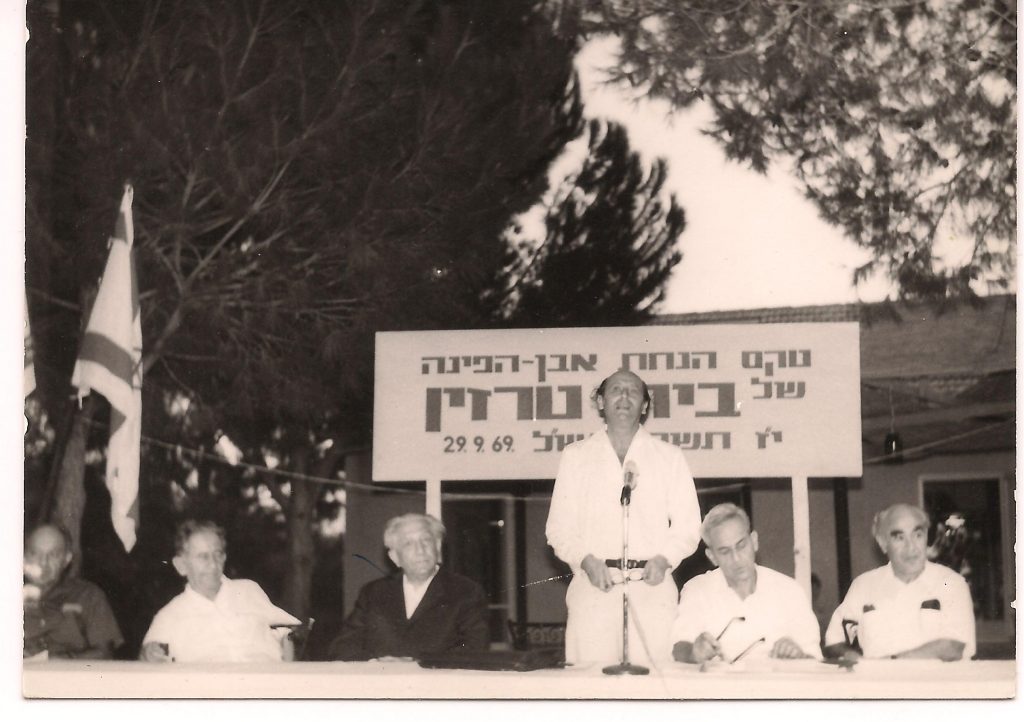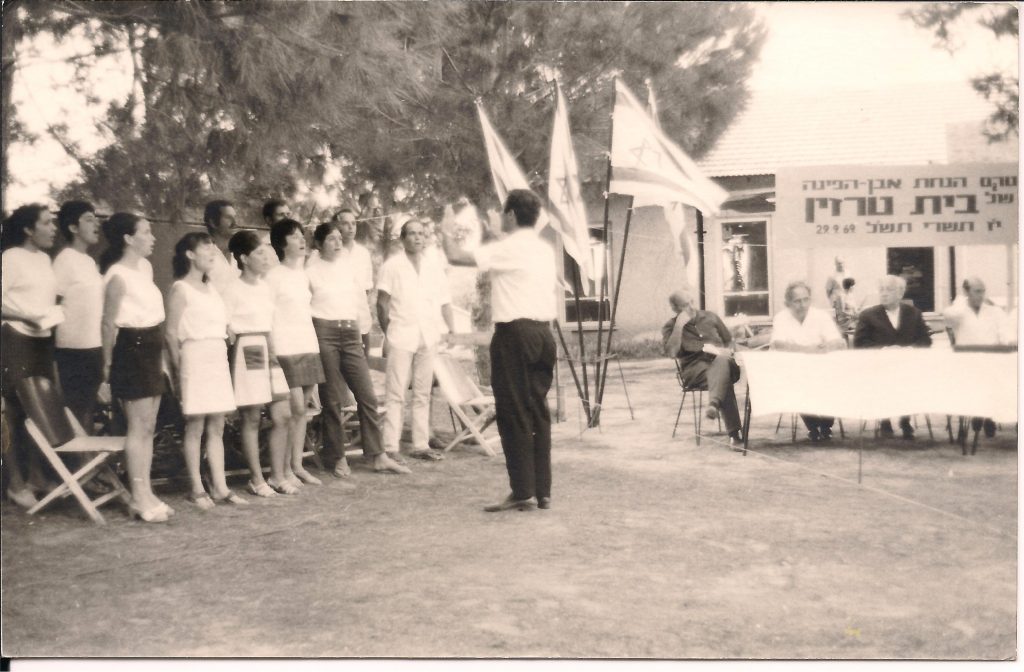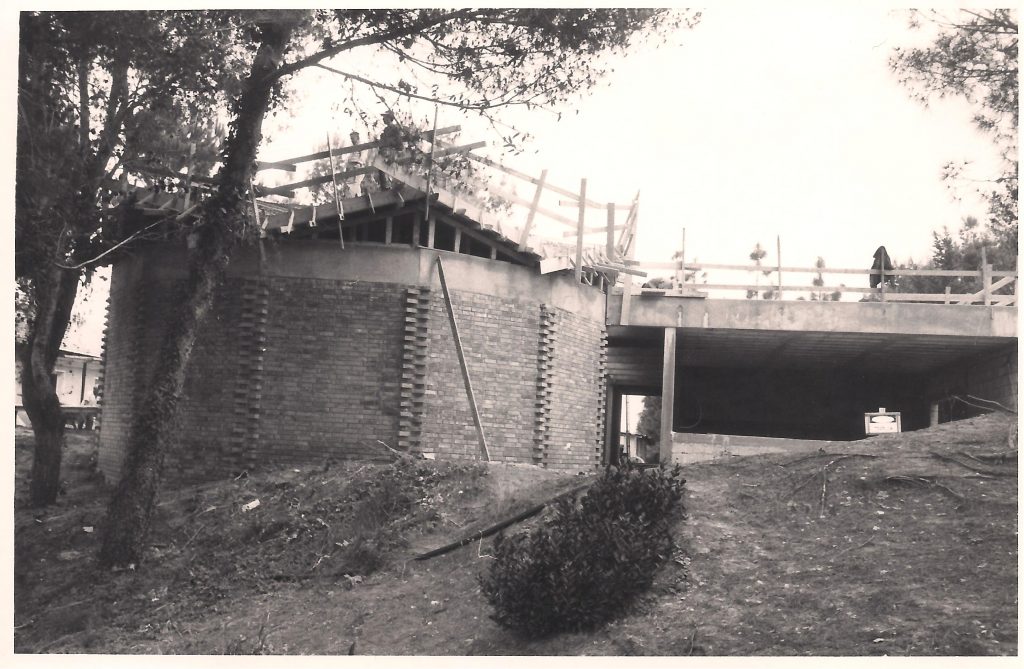Beit Theresienstadt
דף הבית » Beit Theresienstadt » The Founding of Beit Terezin
The Founding of Beit Terezin
The dim sensation felt by the about 150 members present at our May 1955 first gathering, ripened – after twenty five years since the liberation, with more economic stability and ability to confront the pain of the past – to a decision : survivors of ghetto Terezin in Israel, together with members of Zionist youth movements among them, have to establish an Association, that not only will organize meetings for the living, but an Educational-Cultural Institution should be founded to honor the memory of those that did not survive, especially the members of Hechalutz headed by Jacob Edelstein, the first Elder of the Jews in ghetto Terezin.
Beyond the perpetuation, there was another reason – even if same was not discussed in the first meetings of the preparatory committee – the communist regime in Czechoslovakia ignored the murder of the Jews as Jews. The Small Fortress in Terezin – during the rule of the nazis was in use as a prison for political prisoners, among them also Jews – became a National Czech Commemoration Place for the victims of fascism. On the memorial plate in the Central Park in Terezin the town, there is not even a trace of the word Jews.
The Pinkas Synagogue in Prague, where after the war all the names of Czech and Moravian victims were hand-painted over its walls, was closed down to visitors during the communist regime. In the beginning due to technical reasons – the humidity spread out from the low foundations of the building to the walls and then because of renovation works – the place remained closed until after the 1989 revolution.
Many of the sittings of the Preparatory Committee (the members actually nominated themselves as there was nobody that could nominate them) – were dedicated to a discussion about principle questions: Is it possible that all other former ghetto prisoners join the Association which is about to be founded in future, or the members of Hechalutz only ? And maybe also all the people whose dearest ones were in transit via Terezin and then perished in the Holocaust? Gradually, during the years the frames were expanded and today all people interested in, supporting the work done and the aims to be reached – may join and be a member of the Association. With the legal registration of the Theresienstadt (Terezin) Martyrs Remembrance Association in 1966 it was clearly stated: More than anything else there is a need of a site (so far the sittings of the Committee took place in cafe- houses or offices of those members who were then in senior positions in all kind of institutions) – a place for gatherings, a site for commemoration and other activities, a central place for safeguarding the documentation and other material needed for research.
In those days, in various cities, there already existed sites for commemoration of victims from various communities according to the Diaspora and Holocaust map – most of them in desolated places during daytime, and during other days of the year too. Members of the Theresienstadt (Terezin) Martyrs Remembrance Association wanted a vivid place, in the middle of a settlement as an integral part of it – the natural choice was Kibbutz Givat Hayim – Ihud, and this in view the following reasons: in spite of the fact that there were fewer and fewer survivors of ghetto Terezin among the members in the Kibbutz (because many of them tried their luck in the cities) but among the kibbutz founders were many born in Germany and Austria, Zionist youth movements graduates, that part of their families had been deported to Terezin and then perished in the Holocaust. These members had a positive approach to the foundation and erection of a house on their Kibbutz premises, or to be more exact, on the premises of Keren Kayemet leased to the Kibbutz.
This and more: Givat Hayim is located in the middle of the country – anyway, the Association’s members were dispersed all over the country – from Sde Nehemia in the Upper Galilee till Beer-Sheva in the south. Then, only very few of them were car owners, and a place in the center of the country will ease the access to all. And mainly: the Kibbutz by itself was viewed as a more suitable place to the spirit of the days in the past era. Actually, almost all of the Czechoslovak youth movements graduates meant to join one of the kibbutzim upon their alyia to Israel, but the reality was stronger than the ideals. Moreover, Jacob Edelstein their leader in time of the occupation, intended too to join the Givat Hayim Kibbutz (then so far not divided) after making the aliya to Israel. Therefore it was decided from the beginning, that part of the building which will be erected in future in Givat Hayim – Ihud, will be also used by the Kibbutz for their own cultural activities. As a result – the Kibbutz allocated a central site for the building, in the heart of its local institutions.
Following the negotiations with the kibbutz, and after Zeev Shek – one of the Association’s founders started his service as Israel’s Ambassador in Austria and obtained from the Jewish Community an obligation for a significant donation, and after fund rising among our members (about one tenth of one month salary), and after the architect Albin Glaser – also one of ghetto Terezin survivors – presented his proposals of the future structure’s shape, three years after establishment of the Association – only then in a festive ceremony, the cornerstone for the building has been laid.





Construction of the building
here were no sharp arguments as to the form of the building: It was obvious that it has to be accomplished within the very limited means that the Association had at its disposal. It has to be built as a very modest but multi-purpose site. As per the architect Albin Glaser’s suggestion there will be a Memorial Room in form of a twelve-sided structure, built of red bricks – to remind the Terezin fortress. For the Kibbutz a theoretical library study-room and a hall for lectures and smaller cultural events, and for the Association : the archive, study-room and a reading hall.
The greatest dispute on the designation of the site erupted between members of the Association’s Managing Committee only in stage when the building of the project started : A short time after the Liberation a Center for Collection of Documentary Material view the Holocaust (Dokumentacni Akce) had started in Prague, financed by the Joint Organization and its manager Zeev Shek., a member of Maccabi Hatzair and an educator in the ghetto. Before making his alyia on a student certificate, in 1946, and because of lack of opportunity to a legal alyia for the other employees of the Center, it was decided that Zeev Shek will take with him to Israel, in his personal luggage, all the documents which were collected so far.
These documents, which were stored at the Hebrew University on Mount Scopus Jerusalem, and therefore could not be approached for many years, were said to become the foundation of the future to be archive of Beit Terezin. But, as per Moshe Sharet’s request – Minister of Foreign Affairs then – not to disperse the documents between small organizations, Zeev Shek who at that time was Sharet’s secretary – transferred the material of Dokumentacni Akce to the archive of Yad VaShem and the research and study hall, that was supposed to be a part of Beit Terezin has been cancelled, although some members strongly opposed same. Contrary to this, owing to Zeev Shek’s good connections during his office in Vienna, he got a copy of card index including data of 160.000 ex-prisoners of ghetto Terezin, according to the transports they were deported. This index was prepared in Prague immediately after the end of the war and has been preserved. This index was of utmost importance, especially after the severance of diplomatic relations between Israel and the Czechoslovak Republic, together with all countries of the Communist Block (except Romania), following the Israel victory in the Six Days War in 1967.
In the course of time it turned out, that there is a chance to build an archive also without the collection of Dokumentacni Akce, and that also small research sites are justified, and it never crossed their mind to compete with the sovereign institution like Yad.VaShem. Additional piercing debate was conducted regarding the mosaic floor in the room of remembrance, because its costs then were thought too high – 100.000 Lirot. There were members who thought that the money will be better invested in an educational project and research. Some of them saw in the mosaic map of ghetto’s streets with all the blocks and buildings, something that the time will erase, some of them thought that the towns map will say something only to those people who were imprisoned in the ghetto, and some of them thought that the mosaic will add to the atmosphere of the lace also to the next generations. The mosaic was accomplished according to Albin Glaser’s scheme, in a workshop in kibbutz Giv’at Hashlosha and the disputes concerning it are long forgotten. Six years passed between the ceremony of laying the corner-stone and the opening of the house for its designated activities, the commemoration room still empty, with only the mosaic and a Torah scroll there. It was obvious that an essence of the ghetto history should be shown and properly visualized there, with few but large illustrations, taking into account the limited means that stood at the disposition of the Association. Propositions for a modern audio-visual display were rejected due to lack of financial means but the suggestion of Albin Glaser was accepted, to project enlarged photo-slides, elucidated from their back side, that will show in essence the development stages of the ghetto.
Tens of meetings, drafts for choosing the right photos and choosing the correct texts to accompany the photos, were needed. Additional four years passed until the display in the commemoration room – today called the Museum – has been accomplished.
Whoever is acquainted with the Czech immigrants – they had majority within the various Preparation Committees – knows that they were not on the side of glittering shows, they were very careful and not willing to be in debt, not very talented in obtaining funds and they stick to their principles: to many of them it seems not proper, not moral and revolting to use also money from German sources, for building a memorial to victims of the Holocaust. Therefore it was decided, already from the start of the Association’s existence (contrary to the ideas of some others, more practical members), that there will be no official appeal to the German government or its institutions for their participation in funding the erection and activating of the house. In the course of time the things changed, slowly, without declarations, either by direct contact with the Germans that were born after the nazi era and wanted the contact with the house, or following change of generations, or due to actual needs and interest of mutual cooperation between both sides, for the same and common aim: to transmit to next generations the information on Holocaust in general and on the history of ghetto Terezin in particular.
In absence of financial resources, besides the membership fees and here and there some donations, the work was based – first in the Association, then in Beit Terezin – almost entirely on volunteers, without salary. The secretariat of kibbutz Givat Haim – Ihud agreed to put Pinda Shefa – one of its veteran members, also from Czechoslovakia, as the manager of the house until 1982. After Pinda came Alisah Schiller, she also being a kibbutz member, and former ghetto Terezin prisoner.
The founders’ generation begun to show signs of weariness, their number thinned, the needs expanded and requested full professional work. As from 1998 the management of Beit Terezin is in the hands of Anita Tarsi, a university Master degree historian (her father in law, Harry Tarsi, formerly Tressler, was a member of the Dokumentacni Akce in Prague and one of the Beit Terezin founders). Oded Breda started to run the place in Feb 2009. In order to secure continuation of the regular activities in Beit Terezin – also after the founders’ generation will not be here anymore – the Association’s committee in 1997 decided that the second generation (and in the future also the third one) will be represented equally with the veterans in all the various committees and in the management as well. Following four of the founders’ chairmen – Zeev Shek, Willy Groag, Uri Bass and Mordechai Livni – Dr. Eli Loewental was elected in 1998 (manager of Drugs Weaning Center at Haifa, second generation) as the Association’s chairman, and Mordechai Livnithat was the chairman during the past five years, is acting as his deputy. Since the year 1976 the Association publishes twice a year, in January and in July, Association’s Newsletter -“Dapei Kesher” , this name reveals one of its main aims : to keep contact between the Members, dispersed over the whole world – U.K., U.S.A., Canada, Germany, Czech Republic, Holland, Denmark, Australia, Chile, Venezuela and more – to keep them informed about Beit Terezin’s activities. In addition to this, the Dapei Kesher bring information on what’s going on in the world regarding events connected with ghetto Terezin and its history: exhibitions, theater, concerts, publishing of books, published studies, memoirs and world newspapers’ reports, meetings, gatherings and congresses. The Dapei Kesher were edited for many years by Ruth Bondy, also one of the Association’s founders, but now, in accordance with the new policy to transmit the Association’s activity to the management of the second generation, the writing and editing of Dapei Kesher went over to her daughter, the journalist Tal Bashan and others. No one can ever tell what the future will bring to the mankind, to the State of Israel, to the Kibbutz Movement, to each one of us : we can only try that Beit Terezin will not only to continue be active but that its activities will expand, as it did during the last years.
Development of Beit Terezin
Things changed over the years, slowly, without declarations, if it is due to direct contact with Germans born after the Nazi period that wanted to be in contact with Beit Terezin, whether due to the generational exchange, whether the needs of the time and the interest in cooperation from both sides, the goal was the same: the transfer of information about the Holocaust in general and the history of ghetto Terezin in particular to future generations.
Because of the lack of funding sources other than membership taxes and donations, the work was based initially in the association and then at Beit Terezin, almost entirely on volunteers. The secretariat of Kibbutz Givat Hayim-Ihud offered that Pinda Shefa, one of its veteran members who was from Czechoslovakia as well, will manage Beit Terezin. He did so til 1982, followed by Aliza Schiller, also a member of the kibbutz, one of the former Terezin prisoners. The generation of the founders got tired and declined, the needs expanded and demanded full professional work. In 1998, the management of Beit Terezin was given to Anita Tarsi, a historian with a master’s degree (her father-in-law, Ari Tarsi, formerly Tresler, was one of the “Dokunemtazny akzy” and one of the founders of Beit Terezin) . In 2009, Oded Breda started his work as director of Beit Terezin, also a second-generation to a family of Holocaust survivors from the city of Brno, Czech Republic, who spent a long time in the ghetto until they were sent to Auschwitz. In 2015, Tami Kinberg replaced Oded Breda as director of Beit Terezin after managing the educational center since 2008, Tami has a master’s degree in history – her thesis was on the subject of the elderly Jews in Ghetto Theresienstadt.
In 2011, the State of Israel recognized Beit Terezin as “accredited museum”, the 54th in Israel and the third among Holocaust museums.
In order to ensure the continued functioning of Beit Terezin even after the withdrawal of the founding generation, the Board decided in 1997 that members of the second generation (and the third in the future) will be equally represented with the veteran members in the various committees of the association. After four chairmen of the founding generation – Zeev Shek, Willi Groag, Uri Bass and Mordechai Livni – Prof. Eli Lawental was elected in 1998 as the chairman of the organization. After his death in 2020, Daniel Shek was elected chairman of the association and currently holds the position.
Newsletter of the Association
Since 1976, the association and Beit Terezin have published twice a year the “Dapei Kesher” newsletter, whose name attests to one of its main goals: to maintain the connection between the members of the association scattered throughout the world – England, the United States, Canada, Germany, Holland, Denmark, Australia, Chile, Venezuela and more – and update them on the activities of Beit Terezin. In addition, the newsletter provides information about events around the world that are connected to the ghetto and its history: exhibitions, plays, concerts, book publishing, research publications, memoirs and articles in world newspapers, meetings, seminars and conferences. Ruth Bondy, who is one of the founders of the association, wrote and edited the newsletter for many years.
No one can know what the future will bring – for humanity, for the State of Israel, for the kibbutz movement, for each of us; we can only try to make Beit Terezin not only continues but expands its activities as it has done in recent years.
Newsletter Sign up

